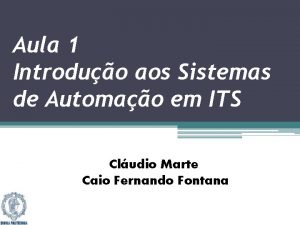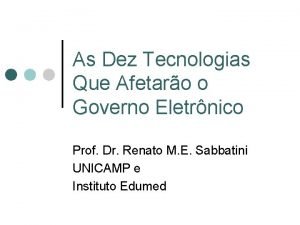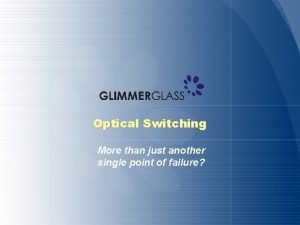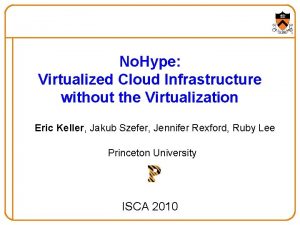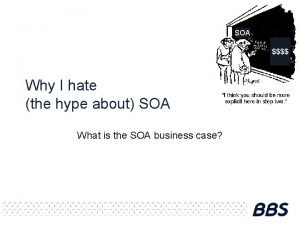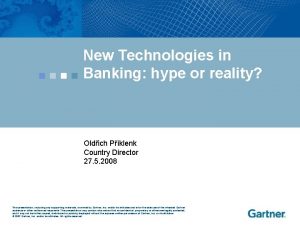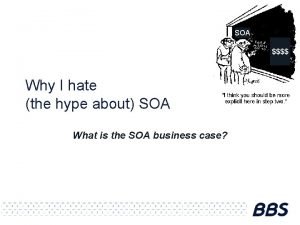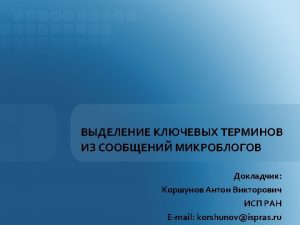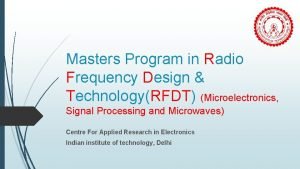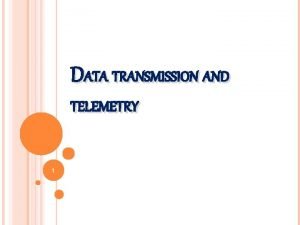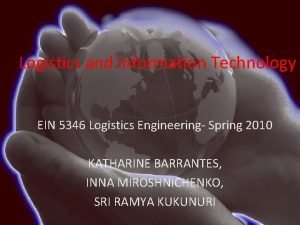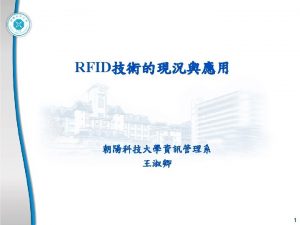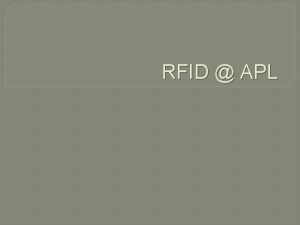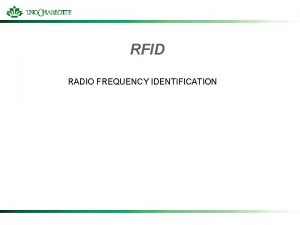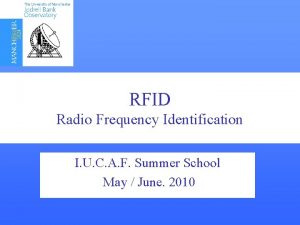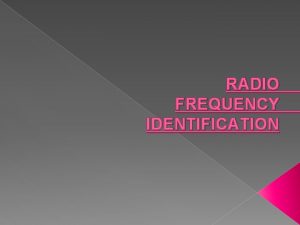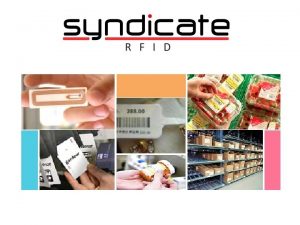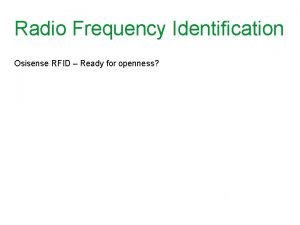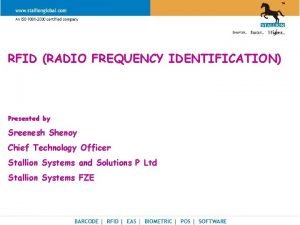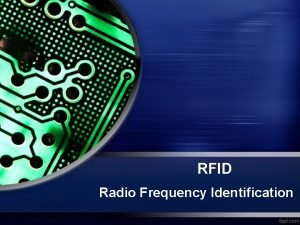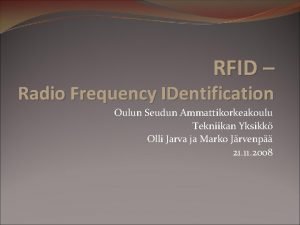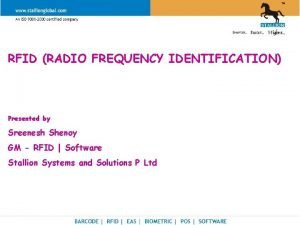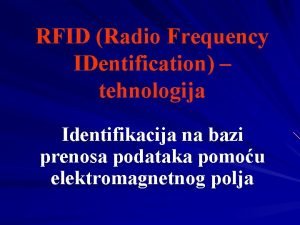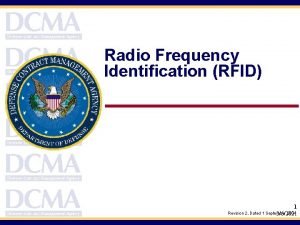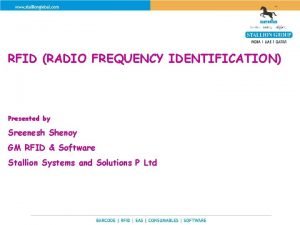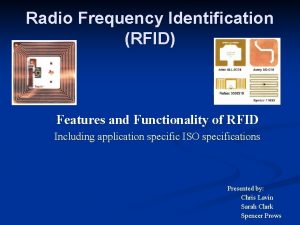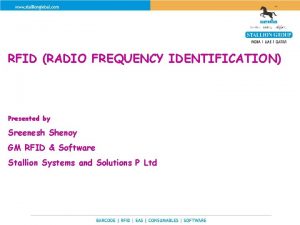Radio Frequency Identification RFID Separating the Hype from




















- Slides: 20

Radio Frequency Identification (RFID) Separating the Hype from the Reality Anthony Furness Technical Director, AIM UK

RFID - Brief History (After Landt, J 2001)* 1940 – 1950 Radar refined and used, major World War II development effort RFID invented – Stockman, H – “Communication by Means of Reflected Power Proc IRE October 1948 1950 - 1960 Early explorations of RFID technology, laboratory experiments 1960 - 1970 Development of theory of RFID and start of field trials 1970 - 1980 Acceleration in RFID development and very early adopters of RFID. First US patent for active RFID appears – Cardullo, MW (1973) – Enter too US government systems and Los Alamos public sector transfer initiative (1977) 1980 - 1990 Commercial applications for RFID enter mainstream 1990 - 2000 Emergence of standards for RFID, greater visibility and uptake – significant developments stimulated by the MIT introduction of Electronic Product Code (EPC) - ISO/IEC JTC 1/SC 31/WG 4 responsible for international RFID standards 2000 - Continuing commercialisation and promotion of RFID, hype and misunderstanding, new radio-based variants of RFID and European and international promotion of RFID and the Internet of Things * Landt, J (2001) Shrouds of Time – The history of RFID, An AIM Publication

RFID - the nature of hype – mainly focused on tags § Devices the size of a grain of rice – chip, but not the device § Can be read at any distance – no, and range depends upon a number of factors § Consume no energy – no, energy consumption dependent on the type of device, passive devices consume energy from interrogation source § Cost next to nothing – no cost dependent upon type – passive devices still cost more than the target 5 cents § Can communicate with one another – not so unless they are active devices with two-way communication capability § Any number can be read at time – not so and certainly not simultaneously – readability depends upon a number of factors § No standards – no, well over 100 standards, including international standards

RFID - the nature of misunderstanding – mainly focused on tags § Tags cannot operate near metal or water – performance in respect of proximity to any materials requires some understanding of electromagnetic theory and practice and of tag and systems design § Tags can be read without line of sight – depending upon the nature of materials and conditions between reader and tag – again requires some understanding of electromagnetic theory and practice and of tag and systems design § RFID Systems to costly – depends upon how appropriate RFID is to the application and well an application for RFID has been designed, bearing in mind the need to justify on economic as well as technical grounds of device, passive devices consume energy from interrogation source

The RFID Data Carriers and Systems benefits key features: § § § § Fast, automatic or semi-automatic data entry Accurate data entry Immediacy of information Additional, process related benefits when effectively applied Identification linkage, options and dividends Radical process improvements, when effectively applied. Fast returns on investment for well defined and implemented applications § Opportunities for object-linked innovation

RFID is important for a number of reasons: § Versatile identification and data carrier technology § Electronic data capture technology, complementary to other automatic identification and data capture (AIDC) technologies § Radical, beneficially disruptive technology when effectively applied § Revolutionary in its relevance to sectors of industry, commerce and services – wide ranging applications § Significant standards development at international level § On-going developments – Internet of Things – the reality!

Applying RFID Effectively requires understanding of… RFID Essential System Elements Radio frequency carrier + coding for communication management purposes Application Commands Antennas Tag Interrogator (Reader / Encoder) Communication Channel RFID Middleware Application Responses Modulated radio frequency carrier - data carried on signal, in this case amplitude modulated Tags representing two different categories of chip-based RFID Host Information Management System – Applications software Wide range of products: Tags Reader / interrogators Software and Services

Applying RFID Effectively requires understanding of… …air interface Antennas Tag Interrogator (Reader / Encoder) RFID Middleware Host Information Management System – Applications software Effectively applying RFID is about better understanding what happens between these antennas and the nature of this depends upon many factors – frequency, power, modulation, encoding, materials and conditions between antennas – practicalities!

Applying RFID Effectively requires understanding of… . . encoding/decoding Antennas Tag Interrogator (Reader / Encoder) RFID Middleware Host Information Management System – Applications software Establishing the best approach to source and channel encoding, and subsequent modulation, followed by appropriate decoding

Applying RFID Effectively requires understanding of… … frequencies & Air Interface Standards ISO/IEC 18000 Series Standards Spectrum Frequency Standard Low frequency < 135 k. Hz 18000 -2 High frequency 13. 56 MHz 18000 -3 UHF 433 MHz 18000 -7 UHF 860 -960 MHz 18000 -6 UHF (Microwave) 2. 45 GHz 18000 -4 Part 1 – Reference architecture & definition of parameters All these have been published National and international agencies specify and govern spectrum usage

Applying RFID Effectively requires understanding of… …RFID Spectrum usage Significantly influenced by SS-based developments – products and infrastructure Dominated by EPC ISO 18000 -6 CGen 2 -based developments – products and infrastructure Significantly influenced by NFC and communication based developments – products and infrastructure

Applying RFID Effectively requires understanding of… …Tag and System design Antenna Design Rectifier & Detector circuitry Tag Circuitry Reader Circuitry Tags require between 10 -40 µW to read – receiving 100 -120 µW Matching circuitry Attention that follows will be confined to antenna considerations Clock – Logic – Decode – Memory I/O circuitry

Applying RFID Effectively requires understanding of… …developments in tag Increased technology cost Modulation Circuitry Rectifier /AC clamp (Passive device) Clock Generator Power-On reset Increased complexity Elements within the chip Increased complexity generally means: • Greater circuit complexity Control logic (incl Anticollision) Security logic Memory select/data transfer control Internal logic/microprocessor • Greater data transfer requirements Memory • Greater power requirements (active vs passive powering) • Greater cost Energy harvesting associated with passive (battery-less) RFID devices generally insufficient to meet higher complexity needs

Applying RFID Effectively requires understanding of… …systems development and Integration: § Near Field Communication § Phone acts as tag emulator § Phone is also a tag reader § Phone is also a tag writer § Re-writable paper and variants § Physical (PR) and chemical (CR) rewrite mechanisms § Integral RFID § RFID Sensors and wireless sensor and actuator networks (WSANs) Sensed data § Machine-to-machine (M 2 M) capability Sensor networks Monitoring and manageme nt DB Server Source: NIA, Korea, 2006.

Applying RFID Effectively requires understanding of… …levels of Identification and data carrier requirements Transportation Large Containers Unit Load “Pallet” RFID having an increasingly significant role to play Transport Unit Package Item Item

Applying RFID Effectively requires understanding of… Standards, other than air interface § GRIFS an EU funded project to identify RFID standards § First deliverable identified 125 standards § http: //grifs-project. eu/db/

Applying RFID Effectively requires understanding of… …processes and RFID attributes that can enhance performance Process Information / data update Information / data IIDs Process Focus Process support Personnel Equipment / asset support Utilities Materials Pa. ID SSPIDs ASIDs UTIDs MIDs LIDs EIDs Knowledge and decision support Focused Process Output Knowledge and support Exploiting identifiers in other processes for information gathering, statistics, management, control and decision support IIDs – Information identifiers, Pe. ID – Process entity IDs, SSPIDs – Process Support Personnel IDs, ASIDs – Asset IDs, UTIDs – Utility IDs, MIDs – Materials IDs, LIDs – Location IDs, EIDs – Event IDs (time stamps)

Applying RFID Effectively requires understanding of… …how it relates to new concepts – such as… Internet Connected The Internet – Endpoint computers Object-connected entities without embedded computers CASAGRAS Inclusive Model – Internet connected …The Internet of Things Application Layer : Web Emails Messaging Specific Domains for Io. T? Specific application structure for the Io. T? ID + Additional Itemattendant data Sensory data carriers Further layers of Data Capture Technology Actuators Host Information Management System Interrogator / Gate way device Networked data carriers Actuators Interrogator / Gate way device Physical interface zone Wider area communications and Networks Host Information Management System Internet +

Is all this understanding really necessary to apply RFID effectively? YES – and more! Especially for: § Systems Integrators § Systems suppliers § Advisors and Consultants § Users who want to have full control over their projects For those new to RFID an awareness briefing that explains in simple terms much of the technical underpinning can go a long way to approaching RFID effectively and asking appropriate questions of vendors, systems integrators

www. race-networkrfid. org To apply RFID effectively requires awareness, education, training in RFID practicalities and business assist for those that are new to RFID …RACE Network RFID can help Thank you for your attention Questions?
 Radio frequency identification
Radio frequency identification Radio frequency identification
Radio frequency identification Paper chromatography method
Paper chromatography method Central pocket vs plain whorl
Central pocket vs plain whorl Glimmerglass optical switch
Glimmerglass optical switch Computing hype problem
Computing hype problem Hype williams
Hype williams Hype driven development
Hype driven development No hype management
No hype management I hate hype
I hate hype Hype nn
Hype nn Cyber hype
Cyber hype Gartner hype cycle banking
Gartner hype cycle banking I hate hype
I hate hype Canoe key pass egret
Canoe key pass egret Hype cycle gartner
Hype cycle gartner Trunked radio vs conventional radio
Trunked radio vs conventional radio Radio frequency design and technology
Radio frequency design and technology Telemetry system
Telemetry system Rf vacuum lumber dry kiln
Rf vacuum lumber dry kiln Radio frequency antenna
Radio frequency antenna
